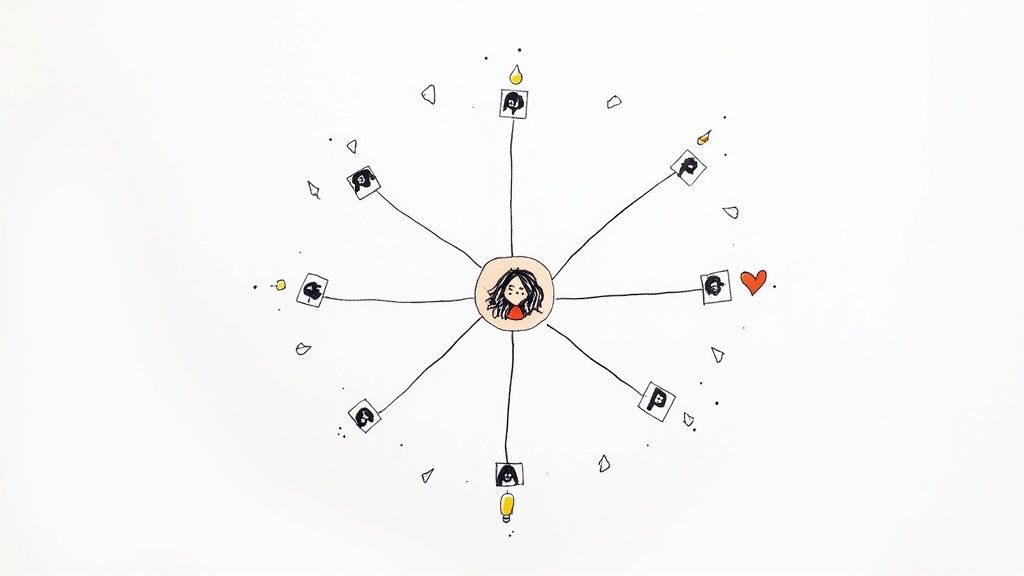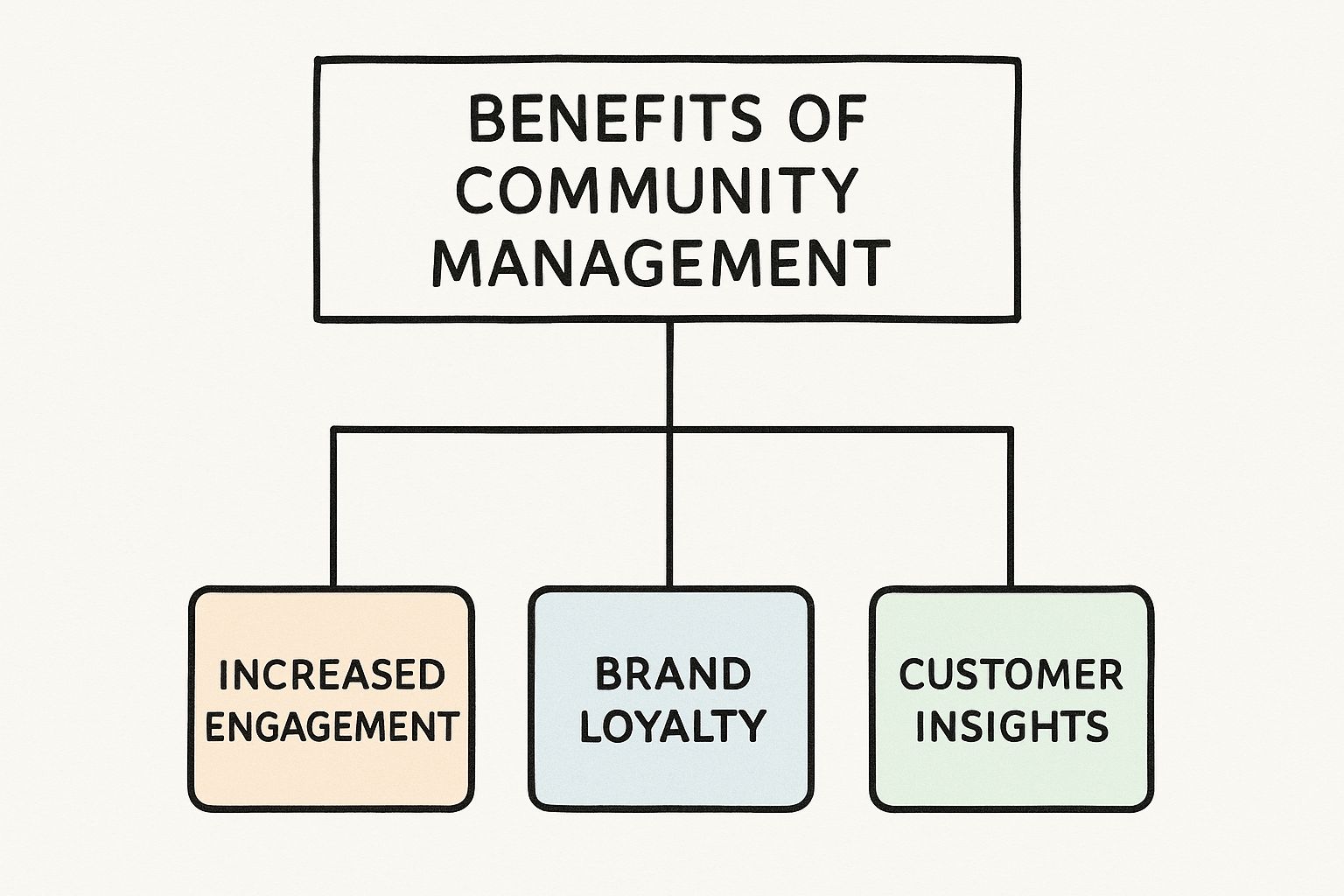September 29, 2025

Social media community management is all about building and looking after a group of people who have gathered around your brand on social platforms. It’s so much more than just firing off replies to comments. The real art is in proactively creating a space where your followers feel a genuine connection—to you and to each other—turning them from casual followers into die-hard fans.
Let’s get one thing straight: this isn’t about just scheduling posts and checking off mentions. That’s an old-school view. Real social media community management is a deeper, more strategic game.
Think of it this way: social media marketing is like a megaphone, broadcasting your message to attract new people. Community management, on the other hand, is like hosting a great backyard barbecue for the people who already showed up. It’s all about nurturing the audience you have.
The whole point is to build relationships, and to do it at scale. You're shifting from a one-way monologue to a lively, two-way conversation. The community manager is the vital link between the brand and the audience, making sure every single member feels seen, heard, and valued. This is how you transform a list of passive followers into a buzzing, active group of supporters.
The day-to-day work of a community manager goes way beyond just policing the comments section. It's a thoughtful mix of tasks aimed at cultivating a healthy and interactive home for your members. You're not just a moderator; you're a culture-builder.
This breaks down into a few key jobs:
The ultimate goal of social media community management is to create a self-sustaining ecosystem where members feel a sense of belonging and ownership. They come for the product but stay for the community.
If you’re still trying to wrap your head around the role, here’s an analogy I love: think of a community manager as the mayor of a digital town. A good mayor doesn't just sit in an office reacting to complaints. They're out there building parks, organizing town festivals, listening to what people need, and making sure the town is a great place to live. They are the community's biggest champion.
A social media community manager does the same thing. They build the "digital infrastructure" by setting up group rules or dedicated discussion threads. They plan "town events" like live Q&As or fun contests. And most importantly, they take the community's feedback and champion it inside the company, making sure those voices help shape products and business strategy.
For a deeper dive into the foundational principles of this role, you can explore the basics of what community management entails in our detailed guide. This people-first approach is what separates a basic social media presence from a truly thriving community.
Building a vibrant online community isn't something that just happens by accident. It's more like architecture. A truly successful social media community is built on a solid foundation supported by four essential pillars. Each one has to work with the others to create a space that feels engaging, valuable, and safe for everyone involved.
Think of these pillars like the legs of a table. If one is weak or missing, the whole thing gets wobbly and unreliable. Mastering each one is how you shift from just "managing" a page to truly nurturing a loyal, self-sustaining group of brand advocates.
Let's break down this framework.
Before you can say a word, you have to listen. Active listening is all about tuning into the conversations happening around your brand, your industry, and even your competitors. It’s about getting a real feel for the pulse of your community—what they love, what drives them crazy, and what they're saying when they think you're not in the room.
This goes way beyond simply tracking brand mentions. It means using social listening tools like Sprout Social or Brandwatch to monitor keywords, hashtags, and overall sentiment. The goal here is to gather insights that can inform everything else you do, from the content you create to the products you develop. Once you understand the conversation, you can join it authentically.
This is where the magic really happens—where relationships are actually built. Authentic engagement isn't about firing off automated replies or generic "Thanks for sharing!" comments. It's about sparking real, two-way conversations that make people feel seen, heard, and valued.
So, what does that look like in practice?
The heart of community management is human connection. Your job is to be the facilitator—the one who creates opportunities for genuine interaction that builds trust and a real sense of belonging.
The image below shows exactly what happens when you get this right. It’s not just about warm fuzzies; a well-managed community leads to higher engagement and fierce brand loyalty.

As you can see, a strong community strategy turns passive followers into active, vocal participants, which translates directly into tangible results for the business.
To help you get started, here's a quick overview of how these four pillars work together. Each has a distinct purpose, but they all support the same ultimate goal: building a strong, self-sustaining community.
By focusing on these four areas, you create a balanced strategy that addresses every aspect of the community experience, from initial interaction to long-term safety and trust.
Content is the fuel that keeps your community running. But we're not just talking about your own marketing messages. Strategic content curation means sharing a balanced mix of stuff that provides real, consistent value to your audience.
Your content calendar should be a blend of your own original posts, helpful articles from other experts, and—most importantly—content created by your own members. The idea is to become a trusted hub of information, not just a brand with a megaphone. This approach keeps your feed fresh, relevant, and centered on what your community actually cares about.
Finally, a thriving community must be a safe one. This pillar is all about creating and enforcing clear guidelines to protect your members from spam, negativity, and harassment. Without solid moderation, even the most positive communities can turn toxic, fast.
This involves three key actions:
Proactive moderation ensures your corner of the internet remains a positive and welcoming place where people feel comfortable sharing and connecting. If you're building from scratch, our guide on how to build an online community from the ground up is a great place to start. Remember, a well-moderated space is the bedrock of trust, and without it, genuine communication can't happen.

As your community grows, so does the noise. The constant stream of comments, messages, and mentions can quickly become a tidal wave, leaving even the most dedicated manager feeling swamped. This is where one of the biggest challenges in modern social media community management comes into play: how do you keep up without losing the personal touch that built your community in the first place?
The answer isn't choosing between efficiency and authenticity. It's about finding the sweet spot where automation and genuine human connection work together.
Think of automation as a brilliant assistant for your community manager, not a replacement. AI-powered tools are fantastic at handling the repetitive, time-sucking tasks that clog up a manager’s day. This frees them up to focus on the high-value work that truly matters—building relationships, thinking strategically, and creating a space people love.
The best way to use automation is for tasks that are predictable and data-heavy. By letting technology handle the grunt work, community managers can pour their energy into the meaningful interactions that actually strengthen the bonds within the community. The goal is to work smarter, not harder.
Here are a few key areas where automation is a game-changer:
The point of automation isn't to fake a human connection. It's to clear the path so that real human connections can happen more often and more meaningfully.
This isn't just a theory; it's becoming the industry standard. A recent study found that 89% of social media teams are already using AI tools to help manage their communities. As you can see in the 2025 HeyOrca Community Benchmark Report, there's been a major shift toward letting tech handle the routine stuff so managers can focus on genuine engagement.
While automation handles the volume, the human touch is what builds trust and loyalty. It's irreplaceable. Some tasks should always be reserved for a person who can bring the empathy, nuance, and personality that no algorithm can replicate. After all, real community is built on authentic interactions, not canned responses.
A chatbot can’t share a member’s excitement about a personal milestone or offer a sincere shoulder to lean on during a tough time. These are the moments that create deep, lasting connections and turn casual followers into passionate advocates for your brand.
To keep your community feeling real and personal, make sure a human is always leading these critical activities:
Finding this balance is the secret to scaling your community management without losing your soul. When you use automation to support—not replace—your community manager, you create a system that’s both efficient and deeply human. For a deeper dive, check out these proven member engagement strategies to foster a thriving community.

When you're building a social media community management plan, one of the first big questions you'll face is where that community should live. Do you focus on your public-facing Instagram page, or do you build a private, members-only Facebook Group?
For most brands, the answer isn't "either/or." It's "both."
Public channels and private groups are two sides of the same coin. Think of your public profiles as the town square—they're wide open, perfect for announcements, attracting newcomers, and making your brand visible to everyone. A private group, on the other hand, is more like an exclusive clubhouse for your most dedicated fans who want to connect on a deeper level.
Understanding how to use each of these spaces is the secret to building a complete, thriving community ecosystem.
Your main social media channels—your Facebook page, Instagram profile, or TikTok account—are essentially the front door to your brand. They are built for maximum reach and discovery, casting a wide net to pull in potential new community members.
This is where your top-of-funnel activities shine. You use these platforms to share polished content, run big campaigns, and engage with a very broad audience. The primary goal is simple: grab attention and create that initial spark of interest.
The nature of these interactions, however, is often surface-level. A comment on a public post is a fleeting moment, not a deep conversation. That’s perfectly fine; public channels are designed to speak to the many, not to nurture the few.
This is where the real magic of community building happens. Private spaces—like a dedicated Facebook Group, a Slack channel, or a custom community on a platform like GroupOS—create a controlled, more intimate environment for your most engaged followers.
In a private group, the dynamic shifts from broadcasting to genuine conversation. Members feel safer sharing their thoughts, asking detailed questions, and actually connecting with one another. This exclusivity creates a powerful sense of belonging that a public page simply can't match.
A public page attracts followers, but a private group cultivates advocates. The shift from an open forum to a closed community is what transforms passive listeners into active, loyal participants.
For a masterclass in this, just look at Peloton. The official Peloton Member private Facebook group has ballooned to over 470,000 members as of March 2025. It's a buzzing hub where people share progress, find motivation, and bond over shared goals, building a fierce loyalty that a public page alone could never achieve. You can learn more about social community management insights from top-tier brands like this.
The most successful community strategies don't make you choose. They use a hybrid model where public and private spaces work together in perfect harmony.
Picture it like a funnel. Your public channels are the wide mouth at the top, drawing in a large audience with great content. From that crowd, you can strategically invite your most interested and active followers into the exclusive private group.
This approach gives you the best of both worlds:
Public Channels (The Town Square):
Private Groups (The Clubhouse):
By integrating both, you create a seamless journey. People can discover your brand in the bustling town square and, if they connect with what you're doing, get an invitation to the exclusive clubhouse where the real relationships are forged. This dual strategy makes sure your brand is both visible to the masses and deeply valuable to its core supporters.
Let's be honest: getting a real budget for social media community management can feel like pulling teeth. Leadership hears "community" and often thinks "fluff." They want to see cold, hard numbers, but the real magic of a community doesn't always show up in a simple "likes" or "followers" report.
To get the investment your community deserves, you have to change the conversation. It's not about "engagement"—it's about impact. You need to show that your community isn't just a line item expense; it's a powerful engine for growth.
The first step is to completely reframe what "success" means. A huge follower count looks great on a slide, but it doesn't keep the lights on. We have to start tracking metrics that actually matter to the C-suite. To really show the tangible benefits, understanding how to measure social media ROI is absolutely critical.
Start focusing on Key Performance Indicators (KPIs) that tell a clear business story:
A community's real value is measured in loyalty, not likes. Proving this means translating the health of your community into the language of business: revenue, retention, and cost reduction.
To get true buy-in, you have to align your community goals with what the company is trying to achieve. Is the big push this year to expand into a new market? Your community is a goldmine for on-the-ground market research. Is the CEO obsessed with improving customer experience? Show them how the community provides instant peer-to-peer support and unfiltered product feedback.
This kind of alignment is more important than ever. Research from Deloitte Digital's 2025 State of Social report found that while social media budgets grew by an average of 9% last year, brands are only hitting about 69% of their social goals. That’s a massive gap between spending and results, and it screams for better ROI proof. You can read the full research on social media effectiveness to get a deeper look at the challenge.
Once you've got your data, you need to wrap it in a story. Don't just throw a dashboard at your boss. You have to connect the dots and explain what those numbers mean for the business.
Here’s a simple way to frame your pitch:
When you frame your community’s value this way, you shift its perception from a "nice-to-have" marketing channel to an essential business asset. You're no longer just asking for a budget; you're presenting a data-backed plan for growth.

Great community management isn’t about guesswork; it’s about understanding what’s truly happening behind the scenes. To know if your community is actually thriving, you have to move past vanity metrics and dig into the data that tells the real story.
Think of it like checking the vital signs of a patient. A single number, like a high follower count, doesn't mean the community is healthy. It's just one piece of the puzzle. You need a full dashboard of metrics to see what’s really going on under the hood.
This means sorting your key performance indicators (KPIs) into a few core categories that, together, paint a complete picture of your community’s health and its value to the business.
To build a dashboard that gives you real, actionable insights, you should focus your attention on four key areas. Each one offers a different perspective on your community's success, from the daily buzz of conversation to its tangible impact on your company's goals.
Keeping an eye on these areas helps you prove the value of your work. It’s also vital for community managers to understand how to measure content performance effectively to connect their efforts to clear business outcomes.
Getting granular is where the real insights live. Instead of just looking at the total number of comments for the month, try tracking the average comments per post. This simple change gives you a much clearer picture of how engaging your content is, no matter how often you post.
The most powerful metrics are those that tell a story of connection and value. A high member activity rate is more telling than a large follower count because it shows people are not just present—they are participating.
The table below breaks down a few of the most important metrics you should have on your radar. For a much deeper dive, check out our guide on https://groupos.com/blog/community-engagement-metrics.
Tracking the right numbers is essential for understanding the health, engagement, and business value of your social media community. Here's a look at some of the most critical metrics to monitor.
By focusing on this balanced set of metrics, you can move beyond simple numbers and start telling a compelling story about how your community is making a real difference.
Even with the best strategy in place, the day-to-day work of social media community management is full of little curveballs. Let’s tackle some of the most common questions that pop up, from getting those first members to dealing with difficult people.
The secret is to start small and be incredibly focused. Your first goal isn't to get a thousand members; it's to find the right ten. Pinpoint your ideal audience and learn exactly where they already hang out online.
Once you know where to find them, start sharing genuinely helpful content and sparking conversations about things they actually care about. Make creating a welcoming, positive space for these first few members your top priority, not chasing vanity metrics. Their great experience is what will eventually draw in more like-minded people organically.
You absolutely need a game plan before things go south. First, create a set of simple, clear community guidelines. Then, the most important part: enforce them consistently and fairly for everyone. This takes the guesswork and personal feelings out of moderation.
When you get legitimate negative feedback, always respond publicly with a bit of empathy, then offer to take the conversation private to solve the problem. This shows the rest of the community you’re listening and you care. But for true trolls—people just there to cause trouble—you have to be decisive. Remove their posts and, if you have to, ban them without a second thought.
Protecting the positive, safe atmosphere of your community is your number one job. A healthy environment is far more valuable than trying to please one person who is determined to disrupt it.
There's no magic answer here. The best platform is simply the one where your target audience already loves to spend their time. Don't try to force them to come to you; go to them.
Do your homework and find out where your people are. Building on their home turf makes it infinitely easier to get things off the ground.
Ready to build, manage, and scale your community with a single, powerful tool? GroupOS provides everything you need to manage memberships, host events, and foster deep engagement in one branded platform. Start your free trial and see how easy it is to grow your community at https://groupos.com.


